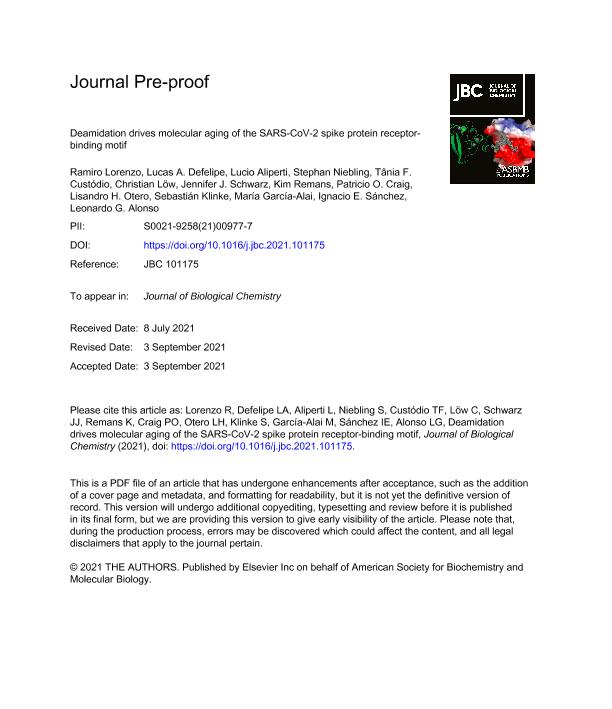Artículo
Deamidation drives molecular aging of the SARS-CoV-2 spike protein receptor-binding motif
Lorenzo Lopez, Juan Ramiro ; Defelipe, Lucas Alfredo
; Defelipe, Lucas Alfredo ; Aliperti Car, Lucio
; Aliperti Car, Lucio ; Niebling, Stephan; Custódio, Tânia F.; Löw, Christian; Schwarz, Jennifer J.; Remans, Kim; Craig, Patricio Oliver
; Niebling, Stephan; Custódio, Tânia F.; Löw, Christian; Schwarz, Jennifer J.; Remans, Kim; Craig, Patricio Oliver ; Otero, Lisandro Horacio
; Otero, Lisandro Horacio ; Klinke, Sebastian
; Klinke, Sebastian ; García Alai, María; Sánchez Miguel, Ignacio Enrique
; García Alai, María; Sánchez Miguel, Ignacio Enrique ; Alonso, Leonardo Gabriel
; Alonso, Leonardo Gabriel
 ; Defelipe, Lucas Alfredo
; Defelipe, Lucas Alfredo ; Aliperti Car, Lucio
; Aliperti Car, Lucio ; Niebling, Stephan; Custódio, Tânia F.; Löw, Christian; Schwarz, Jennifer J.; Remans, Kim; Craig, Patricio Oliver
; Niebling, Stephan; Custódio, Tânia F.; Löw, Christian; Schwarz, Jennifer J.; Remans, Kim; Craig, Patricio Oliver ; Otero, Lisandro Horacio
; Otero, Lisandro Horacio ; Klinke, Sebastian
; Klinke, Sebastian ; García Alai, María; Sánchez Miguel, Ignacio Enrique
; García Alai, María; Sánchez Miguel, Ignacio Enrique ; Alonso, Leonardo Gabriel
; Alonso, Leonardo Gabriel
Fecha de publicación:
09/2021
Editorial:
American Society for Biochemistry and Molecular Biology
Revista:
Journal of Biological Chemistry (online)
ISSN:
0021-9258
Idioma:
Inglés
Tipo de recurso:
Artículo publicado
Clasificación temática:
Resumen
The spike protein is the main protein component of the SARS-CoV-2 virion surface. The spike receptor-binding motif mediates recognition of the human angiotensin-converting enzyme 2 (hACE2) receptor, a critical step in infection, and is the preferential target for spikeneutralizing antibodies. Post-translational modifications of the spike receptor-binding motif have been shown to modulate viral infectivity and host immune response, but these modifications are still being explored. Here we studied asparagine deamidation of the spike protein, a spontaneous event that leads to the appearance of aspartic and isoaspartic residues, which affect both the protein backbone and its charge. We used computational prediction and biochemical experiments to identify five deamidation hotspots in the SARS-CoV-2 spike protein. Asparagine residues 481 and 501 in the receptor-binding motif deamidate with a half-life of 16.5 and 123 days at 37°C, respectively. Deamidation is significantly slowed at 4°C, indicating a strong dependence of spike protein molecular aging on environmental conditions. Deamidation of the spike receptor-binding motif decreases the equilibrium constant for binding to the hACE2 receptor more than 3.5-fold, yet its high conservation pattern suggests some positive effect on viral fitness. We propose a model for deamidation of the full SARS-CoV-2 virion illustrating how deamidation of the spike receptor-binding motif could lead to the accumulation on the virion surface of a nonnegligible chemically diverse spike population in a timescale of days. Our findings provide a potential mechanism for molecular aging of the spike protein with significant consequences for understanding virus infectivity and vaccine development.
Archivos asociados
Licencia
Identificadores
Colecciones
Articulos(NANOBIOTEC)
Articulos de INSTITUTO DE NANOBIOTECNOLOGIA
Articulos de INSTITUTO DE NANOBIOTECNOLOGIA
Citación
Lorenzo Lopez, Juan Ramiro; Defelipe, Lucas Alfredo; Aliperti Car, Lucio; Niebling, Stephan; Custódio, Tânia F.; et al.; Deamidation drives molecular aging of the SARS-CoV-2 spike protein receptor-binding motif; American Society for Biochemistry and Molecular Biology; Journal of Biological Chemistry (online); 279; 4; 9-2021; 1-25
Compartir
Altmétricas
Items relacionados
Mostrando titulos relacionados por título, autor y tema.
-
Mayol, Gonzalo Federico ; Defelipe, Lucas Alfredo ; Arcon, Juan Pablo ; Turjanski, Adrian ; Marti, Marcelo Adrian (American Chemical Society, 2022-08)
-
Uhart, Marina ; Flores, Gabriel; Bustos, Diego Martin (Nature Publishing Group, 2016-05)
-
Fernández, Julián Francisco; Lavecchia, Martín José (Taylor & Francis, 2020-12-28)



